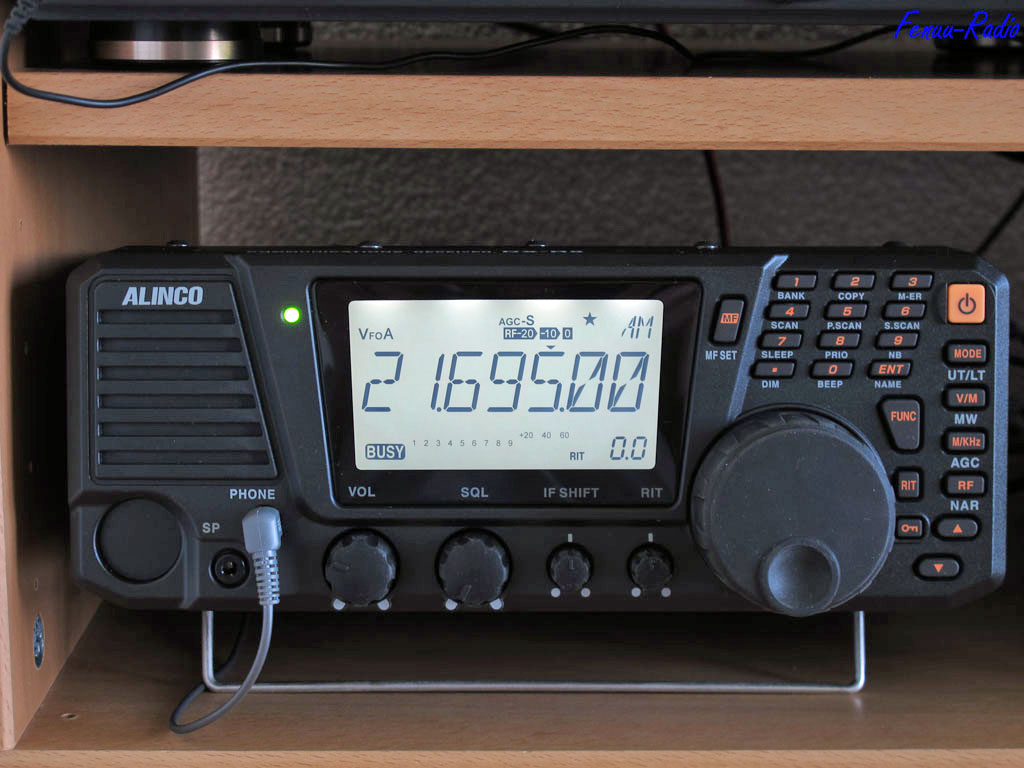|



Alinco DX-R8E
A new
shortwave receivers sees the light of day... The Alinco DX-R8E.
Supposing that manufacturers of shortwave hardware would have
stopped building receivers, now we are disabused.
The Alinco DX-R8 is in fact not a specially developed receiver, it
descends from amateur transceiver Alinco DX-SR8, which is mostly
identical with the DX-R8. Except for the microphone connector, which
is missing on the R8. Alinco made it very easy that way.
The microphone connector was left out, but the slot stayed where it
was built in. This does not look very nice.
I would even pay more for a front panel without this ugly slot. For
selling the DX-SR8 as a pure receicer, the transmitter unit has been
left out. When removing the top cover of the receiver, one is
astonished when looking into this empty chassis. Yes, there had been
the transmitter unit. The actual receiver is located in the lower
half of the chassis. But even in this view one is asking: Isn't
there anything else? A plate with some few components.
The chassis is of die cast aluminium. The front panel can be
unscrewed and with an optional cable it is even remote usable.
The mechanical buildup can be named as stable. The big VFO-knob
makes fun out of turning all over the bands. The big and brightly
illuminated display looks really fine and informs on the most
operating states.
The equipment consists of a bandpass tuning knob, a RIT knob - which
is quite unusual for a receiver with 10 Hz tuning - and a lot of
scanning functions. A special feature are the three switchable IF
filters. But the AM filter of 9 kHz bandwidth is an absolute
compromise. The filter might be of use for NFM. When I bought the
Receiver, it was replaced by a high quality 6 kHz filter instead.
Another nice feature is done by the R8 additionally: There is the
possibility to take an IQ signal via a 3,5mm phone jack to a PC. So
you can send a small waterfall spectrum to your screen. Another
optional cable even lets you control the R8 via the PC. So to speak
as a pseudo-SDR. I did not test this function. But I heard from
other SWL that it cannot be compared with a real SDR.
Here the main data:
Frequency range: 30 kHz - 35 MHz
Modes: AM, FM, USB, LSB, CWU, CWL & IQ signal output
3 IF filters: originally: 1 kHz, 2.4 kHz, 9 kHz (my R8 has 2.4 kHz,
4 kHz, 6 kHz)
Memories: 600, alphanumeric, various scanner modes
Reception:
I compared the R8 with the AR7030 and the NRD545. Surely it is an
unfair comparison, because these two play in a higher league. But
the R8 puts up a good fight! The R8 is clearly designed for SSB use.
Of course, as it was an amateur radio transceiver originally. In
mode SSB it really works fine. It at least matches the other
receivers! The SSB reproduction is noiseless and clear, so I have to
say: Hats off!
In AM mode the tide turns. There it has a hard noise similar to the
FM mode. But only, if strong stations are on neighbouring
frequencies.
This might be a sign for a weak large signal tolerance. This was
then confirmed in the densely packed BC bands. Close to strong BC
stations, it mostly gave overmodulation. Maybe the R8 only likes
passive antennas. I could not offer it such one. My main receiving
antenna, the Fenu-Loop/HDLA2 does usually not deliver a too strong
signal. Though the R8 regularly overloaded. The sensitivity is quite
good. In that point, it really copes the reference sets. Except for
below about 2 MHz where it is less sensitive.
Conclusion:
It's a shame Alinco did not take troubles on the design. The slot
for the microphone plug is like a punch on the eye!
Technically seen, the Alinco DX-R8 is a "low cost" unit, which you
should not expect any wonder from. But it has its strong point: The
SSB reception is really fine. I did not often hear something of that
kind. Alltogether it nearly equals the Yaesu FRG100 with the FRG100
having the better large signal behaviour. Working with not too
strong antennas, you can surely live fine with the Alinco DX-R8.




|